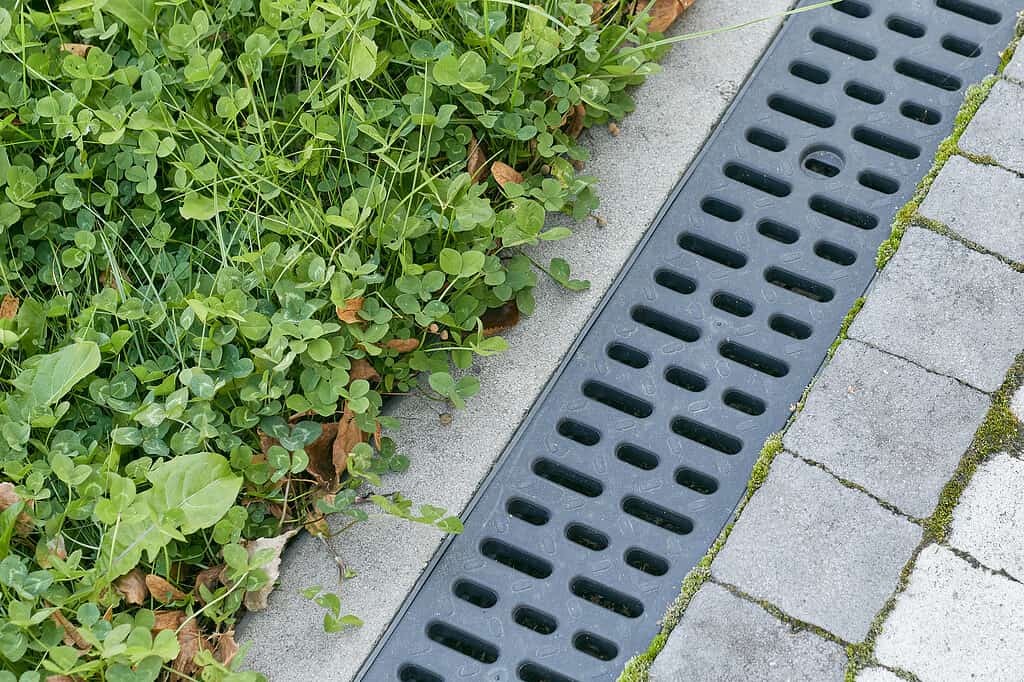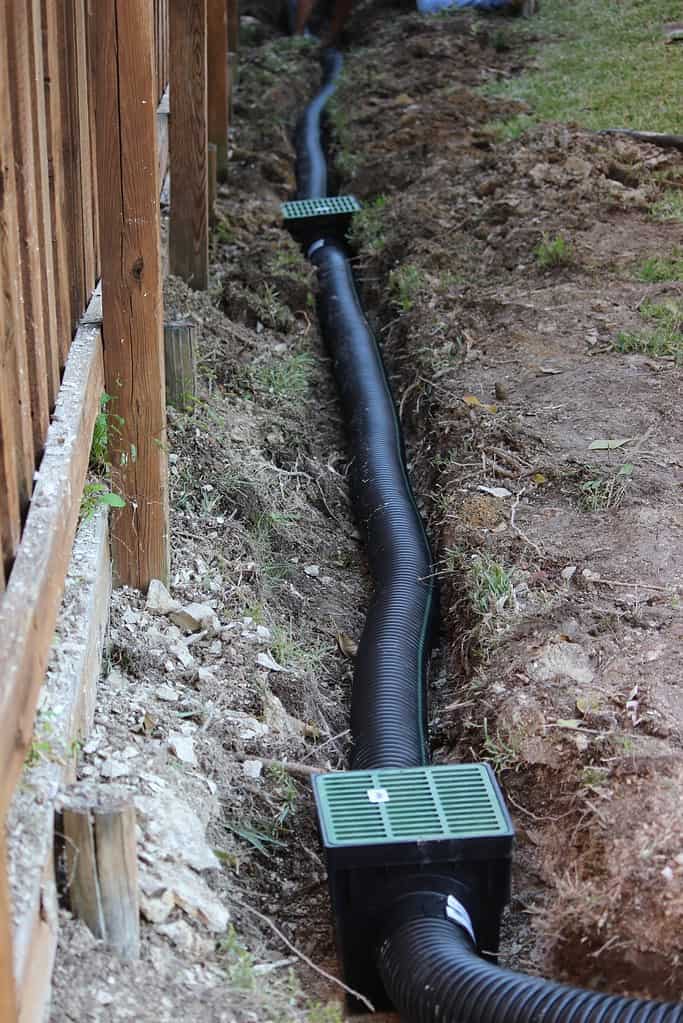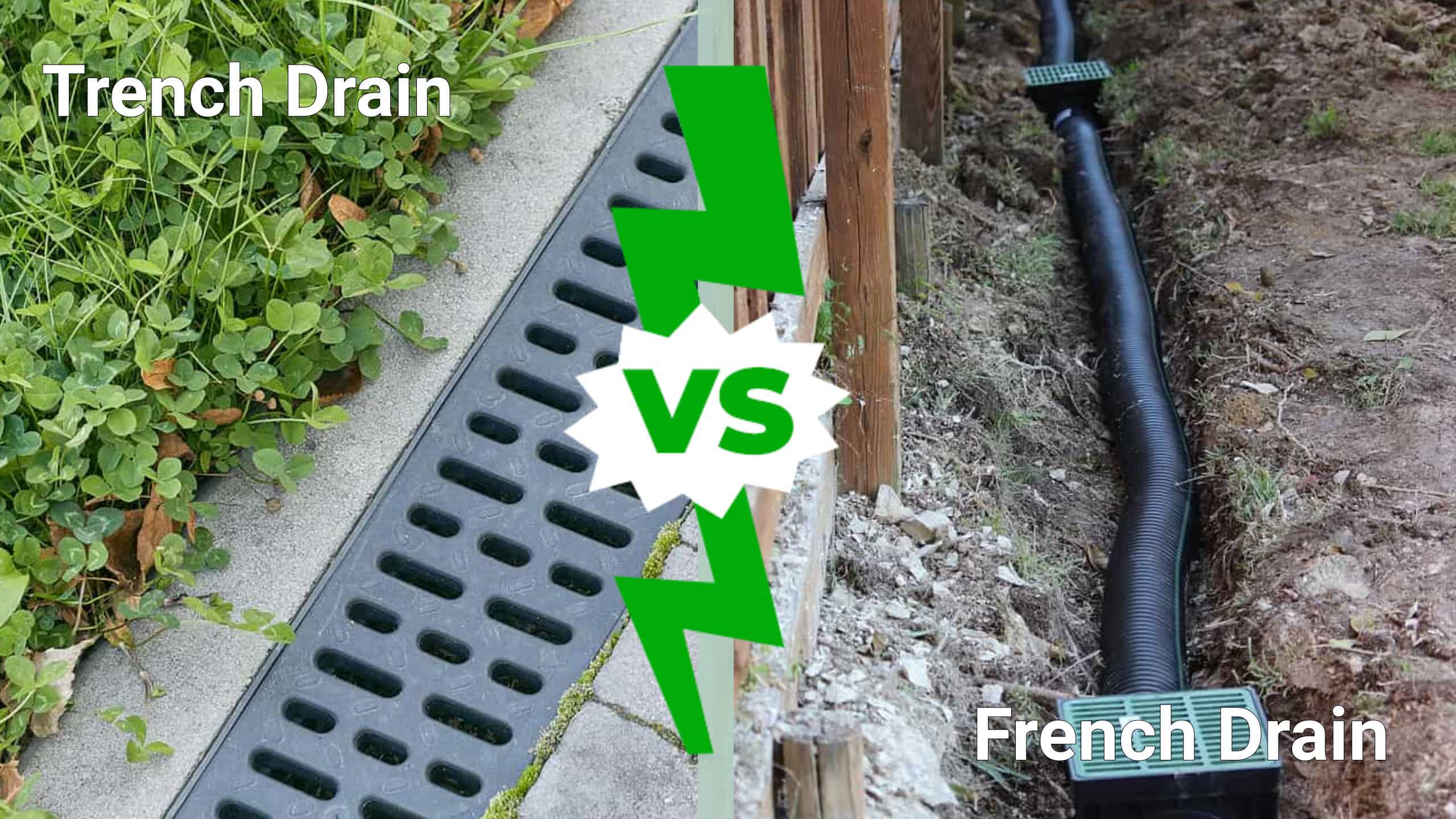Ensuring your yard has proper drainage is integral for protecting your investment and getting the most out of your space. Improperly drained yards may lead to flooding, standing water that attracts pests, or excessive moisture that makes it difficult to mow and enjoy your lawn.
Trench drains, also called channel drains, and french drains are two popular options for homeowners. In this article, we’ll explore the trench drain vs. french drain, outlining key differences and helping you determine which one is right for you.
Let’s dig in!
Trench Drain vs. French Drain: Key Differences
Trench drains and French drains are often confused with one another. In addition to sounding alike, both use dug-out trenches to work. However, there are a few key differences that set these apart from one another.
The most notable difference is their placement in the yard. Trench drains are visible from the surface, with metal grates covering the channel. French drains are buried underground.
While both drains redirect water, trench drains are better for heavy flood zones and rainy areas where water may pool or run down a slope. French drains are better for high water tables, swampy areas, and regular rainfall.
Trench drains require skilled installation, whereas French drains are easier to DIY. However, a poorly installed French drain can cause a lot of trouble — some things are better left to the experts.
Finally, trench drains require regular, simple maintenance while French drains require infrequent yet labor-intensive maintenance.
Read on to explore these differences in more detail.
| Consideration | Trench Drain | French Drain |
|---|---|---|
| Cost | $3,000 – $10,000 | $1,000 – $10,000 |
| Maintenance | Frequent, not labor-intensive | Infrequent, labor-intensive |
| Purpose | Redirect above-ground water to prevent pooling and flooding | Redirect below-ground water to reduce flooding and ground saturation |
| Installation Needs | Skilled installation | DIY potential |
| Depth | Shallow; 3-6 inches | Deep; 12-18 inches |
| Appearance | Visible grates above ground | Not visible; buried |
What Is a Trench Drain?
Trench drains are considered surface drainage, as they’ll be visible in your yard. These systems are shallow and wide, reaching only a few inches deep.
The trench drain is lined with concrete to redirect water rather than letting it absorb into the ground. The channel is covered in a metal grate so water can run in, and you can walk overtop without worries of tripping or stepping into a stream.

Trench drains are shallow with a grate covering the channel.
©Andrii Hibelchuk/iStock via Getty Images
Pros of Trench Drains
Trench drains are highly effective. Here are some of the main benefits of this drainage system.
Ideal for Basement Protection
Trench drains are designed for superior basement protection and water redirection during heavy rains. If you live in an area with pooling water in your yard, heavy rainfalls, or a substantial spring thaw, the trench drain is likely the best option for you.
Works on Negative Slopes
Negative slopes or negative grades are a landscape architecture term regarding how water moves around your home. If you have a negative grade, that means water runs toward your home, putting your basement at increased risk of flooding.
Trench drains are effective at redirecting water and protecting homes on a negative slope.
Works in Shallow Areas
One of the biggest benefits of trench drains vs. French drains is their shallowness. Trench drains don’t have to be deep to be effective. This means less labor or expensive equipment during installation and a decreased risk of hitting any pipes or running into issues while digging. Depending on your area, you may not need a permit for this type of drain (but you should always check!)
Pre-Sloped
French drains must be carefully placed on a minimum 1° slope so water doesn’t sit in the pipe rather than being redirected away. The concrete in trench drains can be shaped to naturally slope with minimal worry about erosion.
Cons of Trench Drains
While the pros of trench drains outweigh the cons, there are a few things to consider.
Nuanced Installation
Installing trench drains is nuanced and requires an expert to do it well. This aspect of trench drains can dramatically increase the cost.
Visible Grating
Trench drains are visible on your lawn, which is unappealing to some as it takes away from the natural ambiance. However, you can select grate covers that suit your style to offset this issue.
Prone to Surface Blockages
Trench drains are more susceptible to blockages, as leaves, twigs, clippings, and debris can block the grates. You’ll need to be vigilant about raking your leaves and checking for issues.
Requires Regular Maintenance
Staying on top of your grate-clearing efforts requires regular maintenance. Fortunately, removing leaves and debris is relatively straightforward.
What Is a French Drain?
French drains are underground, typically 1-2 feet deep, and not visible on the surface. These systems are narrow and consist of a PVC pipe or drainage hose with holes drilled into the top. The pipe is typically covered with a layer of gravel and a non-woven geotextile fabric like landscape fabric to filter sediment.
As water seeps into the ground, it drips into the pipe and is redirected away. French drains work best in wet yards rather than areas with pooling and flooding.

French drains are ideal for areas with high water tables.
©Jasmine Sahin/Shutterstock.com
Pros of a French Drain
A few significant benefits lead people to choose a French drain over a channel drain.
Possible to DIY
With the right equipment and some basic handy skills, you can DIY a French drain. This is a solid weekend project using items available at the local home store.
However, care and attention to detail are crucial. A poorly installed French drain causes more harm than good.
Potential for Lower Cost
If you take a DIY approach to installing a French drain, you may save hundreds on labor.
Out of Sight
French drains are not visible on the surface, and no ugly grates will interrupt the natural beauty of your yard.
Requires Minimal Maintenance
French drains are pretty much out of sight and out of mind. They require infrequent maintenance and are less prone to blockages from yard debris.
Cons of a French Drain
Unfortunately, many downsides to a French drain lead to some experts advising against them. Here are a few common concerns with this approach.
Insufficient for High Water Quantities
French drains are not appropriate for basement protection, particularly in areas with heavy rainfall or negative slopes.
Not Effective in Clay Soil
Check your soil before committing to a French drain. These drains work well when water can seep through the soil into the drain. If the soil lacks drainage, the water won’t reach the pipe, and the French drain will be useless.
Labor-Intensive Maintenance
Fortunately, French drains don’t require much maintenance. However, when an issue occurs, it’s a big job. You’ll need to dig up the drain to troubleshoot and service it. As the French drain is out of sight and out of mind, you may not notice a potential issue — like squirrels storing a life supply of acorns in your drain — until your basement floods.
Not Suitable for Negative Grades
As French drains require a 1° slope away from the house to function, they may not be appropriate or worth the effort to install in yards with negative grades.
Trench Drain vs. French Drain: How to Choose
Choose a trench drain if you have pooling water in the yard, live in an area with heavy rains, or if your house is on a negative grade.
Choose a French drain if you live in a swampy area or want to reduce water levels in your yard, even though it isn’t putting your basement at risk.
Depending on your property, you may need both in different areas. Talk to a landscape architect to help you decide what’s right for your property.

You can install both a trench drain and a French drain.
©Maryana Serdynska/iStock via Getty Images
Thank you for reading! Have some feedback for us? Contact the AZ Animals editorial team.







